L’éléphant et le toucher électrique : Er forme le 44e système de groupes sanguins antigènes
The running joke is that our long and ever-expanding list of red cell surface antigens exists simply to create jobs for blood bankers. The transfusion of red blood cells (RBCs) might seem to be the easiest feat on Earth if it happens 100 million times annually, though what the ubiquitous act fails to reveal is just how much “behind-the-scenes” work goes in to compatibility- and safety- assurance. Likewise, 140 million babies are born every year, many with blood types different from the birthing parent. RBC rejection (in acute or delayed hemolytic reactions [HTRs], or in hemolytic disease of the fetus or newborn [HDFN]), occurs in less than 1 in every 1000 such encounters, giving the impression that human blood, in standard transfusion practice, mixes uneventfully enough. Those not as familiar with RBC surface marker diversity were therefore understandably surprised – despite Pandemic-driven enhancements in scientific literacy around antibodies, antigens, and “variants of concern” – to learn just how noisy and vulnerable the RBC can be in the crosshairs of the immune system. We do not just express the ABO system (with its four possible blood types [A, B, AB, and O]), or a D type in the Weiner system (“positive” [present] or “negative” [absent]). We express more than 40 other systems, which bear over 340 antigens within those formal bounds, with the possibility of “orphans” in so-called collections and series. Every act of transfusion or pregnancy permits us to see version-differences in shared molecules, or entirely different structures that we ourselves may lack, for an overall seroconversion rate of ~1-10%. The vast majority of the time, we can identify what these antibodies are, but sometimes we are left concluding “unidentified specificities,” with most but not all of these being insignificant.
The recent announcement1 on Er, the 44th system, was both a giant discovery and a re-shuffling of information in our ISBT tables.2 Three different Er antibodies were originally listed in the 200 series (“collection 208”), beginning with the high-prevalence anti-Er(a) in 1982, followed by the antithetical anti-Er(b), and then anti-Er3 (with mild HTRs) in Er(a-b-) individuals. What it took to go from a collection to a system was a series of proofs that these antibodies were targeting facets of a common molecule encoded by a specific gene with immunogenic variant loci. The Bristol group used state-of-the-art sequencing and gene-editing techniques to show that the PIEZO1 gene (on chromosome 16q24.3) – which encodes the Piezo1 mechanosensitive cation channel – was at the root. Piezo1 is an enormous (>2000 amino acid, >30 transmembrane pass) molecule that forms a propeller-like trimer or tetramer, permitting Na+ or Ca2+ (and thus water) influx with membrane pressurization. It is expressed across Kingdoms (from bacteria to mammals) and across tissues (from RBCs to endothelial cells and hollow organs [lungs, colon, kidneys, and bladder]). The discovery work behind this important class of master-sensors was recognized in the 2021 Nobel Prize.3
The Bristol team studied the expression and activity of this “electric touch” molecule further, and added two more antibodies to the list: anti-Er4 and anti-Er5, noteworthy for the sequelae of lethal HDFN.
Though the 13 other new systems identified in the last decade weren’t met with as much fanfare, several features set Er apart. Firstly, there are already five Er antibodies catalogued, and more expected, whereas 10 of the 13 other systems are marked by isoantibody formation alone in those lacking the carrier (ie- a presence vs absence situation, rather than alloimmunization fodder from what appears to be a highly polymorphic gene). Secondly, Er antibodies have occurred in people not from a single consanguineous founder group, but from places as far as Mexico, Germany, Kuwait, and Zimbabwe, ie- resisting the mold of other geoancestry-typical antibodies. Thirdly, a host of other Piezo1 mutations are known to produce disease states, such as the gain-of-function (slow de-activation) autosomal dominant mutation behind the malaria-protective state of dehydrated hereditary stomatocytosis (AD DHS), or the homozygous autosomal recessive loss-of-function state of generalized lymphatic dysplasia with non-immune hydrops fetalis. Knowing this molecule means knowing more about biology and disease. Fourthly, this molecule is present in a much lower membrane copy number than other RBC antigen systems, illustrating that target load is not a predictor of significance.
Though to us, the updated taxonomy on known and new antibodies does not change our practice overnight, a “system” status arguably earns a place of greater priority. For decades, disparate groups of biochemists and serologists saw only the separate parts of an elephant, and now the elephant is whole. Modern laboratory techniques may help shepherd the remaining orphan antigens into the systems of future news stories, and aid in the development of reference laboratory tools and more tailored blood inventories. Charged as we are with providing the right blood to the right patient, we now know more about why this might be hard in some rare cases, and how to go about getting the blood care mission accomplished.
References of Interest:
- 1. La chronologie des événements : le samedi 24 septembre 2022, la Bristol School of Biochemistry et le NHSBT’s International Blood Group Reference Laboratory (IBGRL) du Royaume-Uni publient un communiqué de sur la découverte d’Er, le 44e système de groupes sanguins liés aux antigènes. L’article scientifique est accepté pour publication par la revue Blood le lundi 15 août et publié en ligne à l’avance un mois plus tard, le mardi 20 septembre. L’article est repris dans les médias sociaux et aux nouvelles du soir à l’échelle de la planète pendant tout le mois d’octobre 2022. (ex. https://toronto.citynews.ca/video/2022/10/16/scientists-discover-new-blood-group-er/)
L’article est publié en format papier comme étant d’importance exceptionnelle le 12 janvier 2023 (référence complète : Karamatic Crew V, Tilley LA, Satchwell TJ, AlSubhi SA, Jones B, Spring FA et coll. Missense mutations in PIEZO1, which encodes the Piezo1 mechanosensor protein, define Er red blood cell antigens. Blood. 2023; 141(2):135-46.
https://doi.org/10.1182/blood.2022016504, PubMed PMID : 36122374), et accompagné d’un fichier balado : https://ashpublications.org/blood/pages/blood_podcast_s5ep2 - The ISBT’s Red Cell Immunogenetics and Blood Group Terminology Working Party’s website (https://www.isbtweb.org/isbt-working-parties/rcibgt.html) provides updated tables on antigens within the systems and collections (the 200 series [not meeting criteria for systems][not meeting criteria for systems], and the subsets of the 700 series [low frequency antigens, <1%] and the 900 series [high frequency antigens, >99%]). Er possède maintenant sa propre liste : https://www.isbtweb.org/resource/044er.html
- 3. The 2021 Nobel Prize in Physiology or Medicine: for David Julius and Ardem Patapoutian, and their discoveries of receptors for temperature and touch. https://www.nobelprize.org/prizes/medicine/2021/press-release/ https://www.nobelprize.org/prizes/medicine/2021/press-release/
Newsboard
ORBCoN Tech Assessment
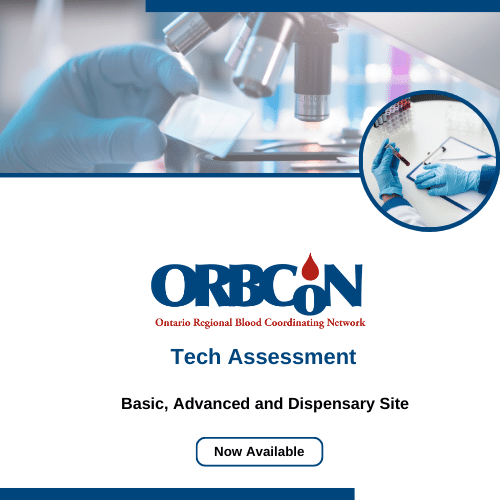
The ORBCoN Technologist Assessment program is now available on the new ORBCoN Learning Management System (LMS) and Surge Learning platforms.
A communication has been issued with instructions to provide site administrator information for access to the ORBCoN LMS and guidance for current Surge Learning clients.
If you have any questions or have not received the communication please reach out to alison.wendt@sunnybrook.ca
Provincial Bedside Audit of Blood Administration
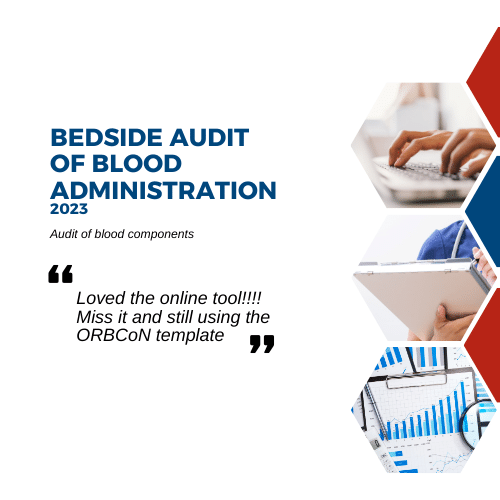
Register: Transfusionists Talk: Transfusion Made Bloody Easy
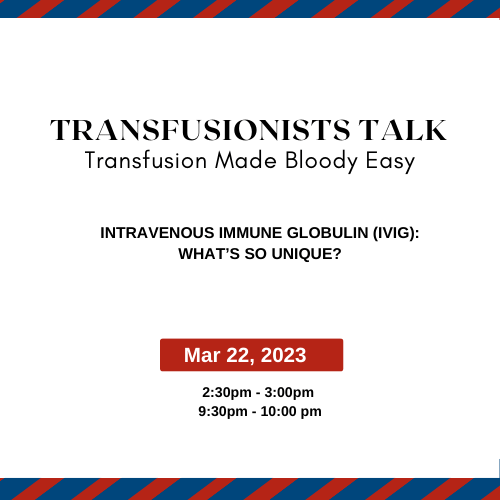
Save the Date: 18th Annual TM Conference
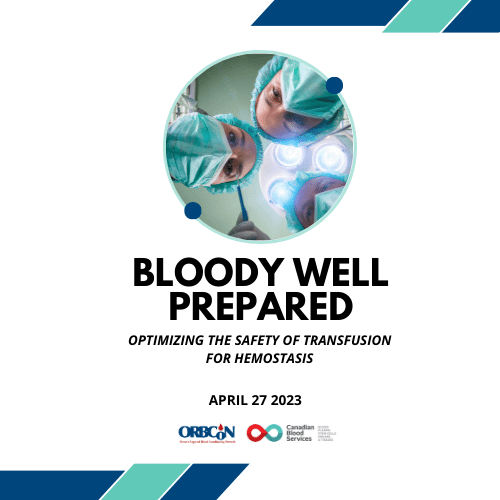
Featured Resources
Frozen Plasma Toolkit
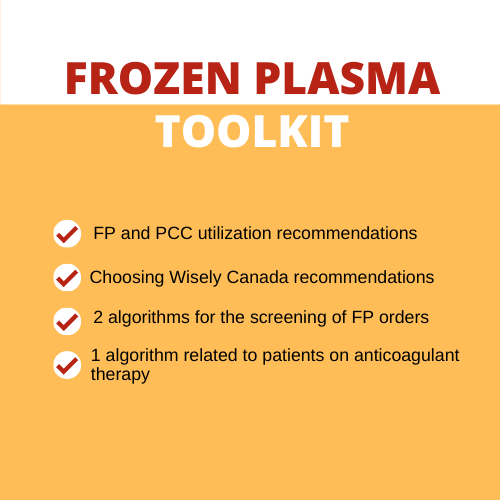
Upcoming Events
UofT TM Rounds

February 23, 2023 @12pm-1pm
ICTMG Behaviour change by Dr. Fabina Lorencatto & Dr. Justin Presseau